0762 Here is how the template applies to the start of the Creation Story.
The idea that God’s initial creatio ex nihilo produces light from darkness (which is the absence of light and is nothing) is evocative, from a scientific point of view.
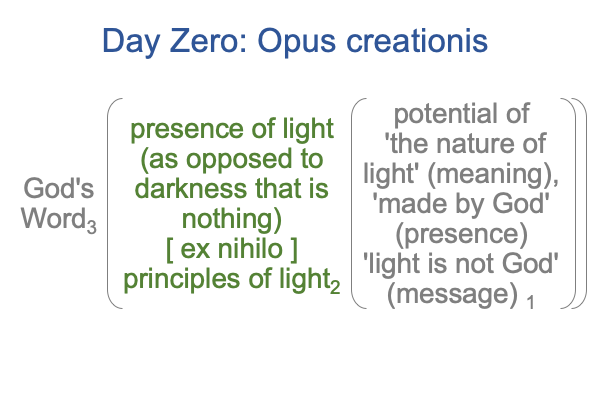
0763 Day one portrays images, indications and symbols that associate to the formation of the solar system.
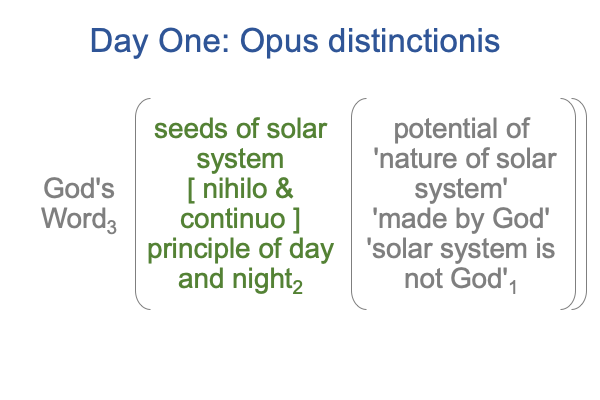
0764 Day two associates to the formation of the planet Earth by way of images, indications and symbols.
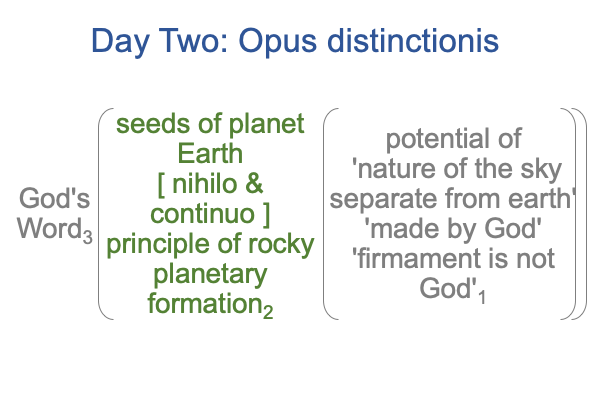
0765 The start of day three contains icons, indexes and symbols that apply to the differentiation of continental from oceanic crust. The earliest continents called “Archean cratons”.
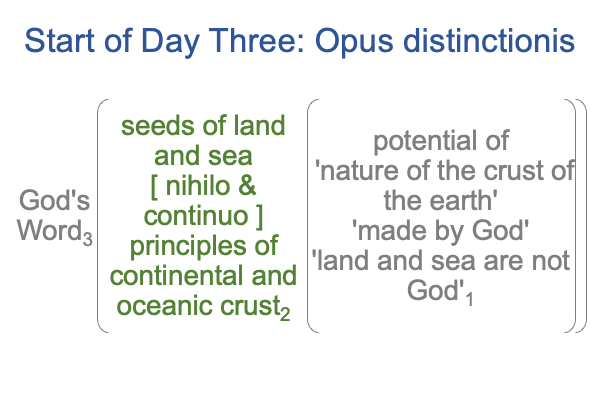
0766 The end of day three offer images, indications and symbols of the start of life and of photosynthesis, which occurs in the same era as when continental crust first appears. This vegetative life is archean and bacterial, so they initially appear as mats, slimes, filaments and so forth. These single-celled organisms can glob together. But, they do not specialize with respect to one another. Therefore, bacterial natural selection is not identical to natural selection for multicellular animals and plants. For example, this photosynthetic cellular life reproduces through mitosis, not through meiosis.
Here, Augustine’s concept of rationes seminales allows the scientific features of the day:age association to shine. Plants bearing seed are not created ex nihilo. But, the esse_ce and essence of photosynthesis and of life associate with this era.
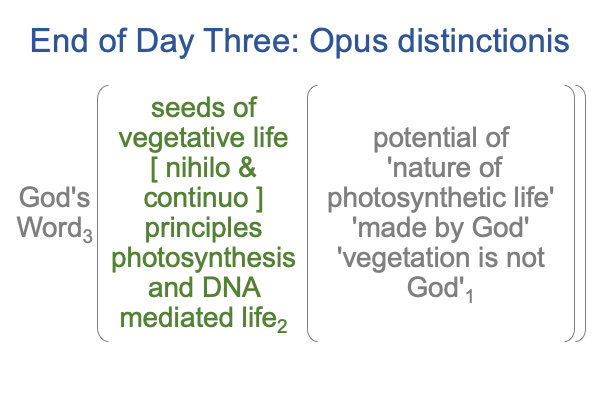
0767 Day four offers images, indications and symbols for the transformation of atmosphere due to release of oxygen by photosynthetic life. Early Earth has an atmosphere rich in nitrogen (as today) along with lots of carbon compounds. Photosynthetic life sequesters the carbon and releases oxygen, which gradually alters the atmosphere from chemically reductive to chemically oxidative. This period lasts billions of years.
Overall, oxygen is released into the atmosphere and carbon is sequestered by photosynthetic life. Complex “reduced” carbon-compounds are also oxidized by exposure to oxygen. The atmosphere slowly goes from hazy, opaque, and translucent (oxygen-poor and carbon-rich) to transparent (oxygen-rich). The sun, moon and stars become visible, to be used as celestial signs by humans.
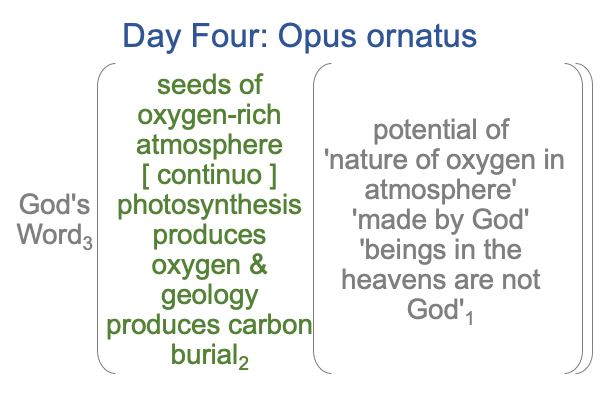
0768 Day five contains images, indications and symbols of the diversification and evolution of eukaryotic cell-based multicellular organisms. Eukaryotic cells contain mitochondria, special organelles devoted to utilizing the chemical potential of atmospheric oxygen (as discussed in points 0242 -0276). Another specialized organelle for eukaryotic cells is the chloroplast. Chloroplasts conduct photosynthesis, using carbon-dioxide as the carbon source. Multicellular plants contain chloroplasts. This era starts with the Precambrian and lasts hundreds of millions of years.
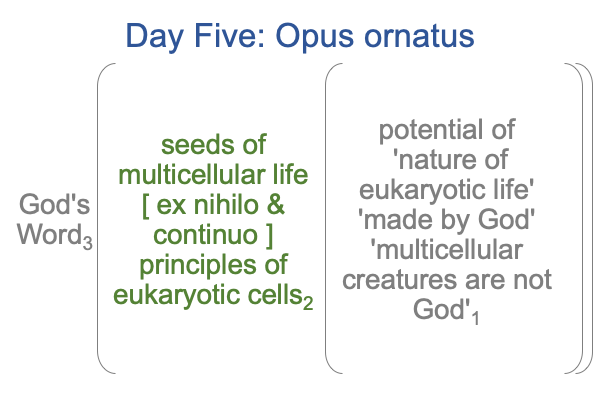
0769 Day six offers images, indications and symbols for the Age of Mammals. The Age of Mammals starts 65 million years ago.
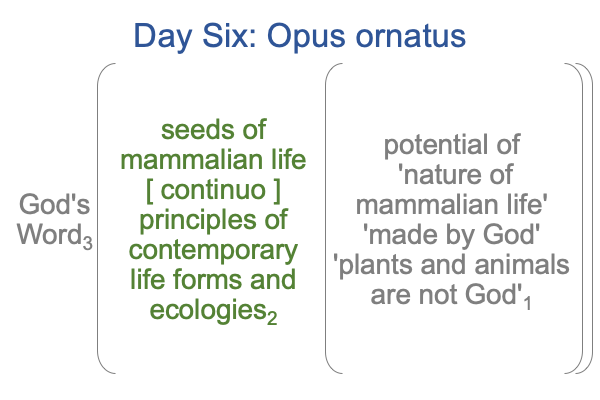
0770 That is not the end of the six days.
Augustine’s concept of rationes seminales also applies to verses associated with the intention of man (Gen. 1:26), creation of man (Gen.1:27), blessing of humans (Gen. 1.28), feeding humans with plants (Gen. 1:29) and feeding plants to domesticated animals (Gen. 1:30).
In the following figures, the day:age association for each verse display novel principles for interpreting the evolution of hominins and humans.
0771 The seeds of the intention of humans associates to the era starting with the appearance of bipedalism and ending with the domestication of fire. The principle is the ultimate niche of the potential of triadic relations. Another name for this niche is “sociogenesis”.
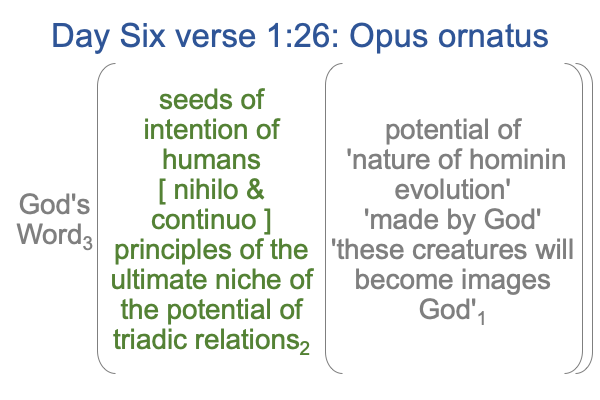
For further information, see Comments on Michael Tomasello’s Arc of Inquiry (1999-2019), by Razie Mah, available at smashwords and other e-book venues.
0772 The seeds for the creation of humans associates to the era starting with the domestication of fire and ending with the appearance of anatomically modern humans, Homo sapiens, in the evolutionary record. The principle includes the voice being used for synchronization for large gatherings (just as the voice is used today by congregations) then coming under sexual selection. Once the voice is under voluntary neural control, the vocal tract is exapted for use as an adornment to hand talk. Humans practice hand-speech talk since the inception of the species, until the first singularity, marking the potentiation of civilization.
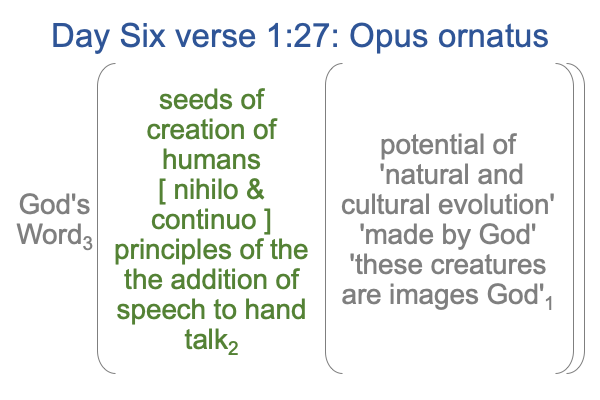
0773 The seeds for the blessing of humans associates to what follows after our species appears in the archeological record, starting over 200,000 years ago. At the time, other hominin species have very similar attributes and tool kits. Then, over thousands of years, our lineage starts to prosper, in ways that the other hominin species do not. By 50,000 years ago, anatomically modern humans are present in Europe with advanced microlithic stone tool kits. Presumably, they are migrating out of Africa.
Humans interbreed with the Neanderthals and another late-hominin species, known only through DNA-extraction from one nearly fossilized bone from Siberia. Why do they interbreed? Humans still practice hand talk. So do the Neanderthal and Denisovans. The difference, though, is that humans are also practicing speech talk. The semiotics of hand-speech talk are yet to be explored by researchers interested in human evolution.
Genetics show that humans interbreed with the Neanderthals and Denisovans. The question to ask is, “Why does interbreeding occur only around 50,000 thousand years ago and then discontinue? Hybrid fragility? Or innovations in hand-speech talk shifts human cultures away from mainly hand-talk and more into a mix of hand and speech talk.”
0774 By around 30,000 years ago, the Neanderthals of Eurasia are extinct and humans clearly exhibit “modern” behavior. To many, Paleolithic art is more beautiful and evocative than most “modern” art. Plus, Paleolithic folk are not nearly as corrupt and degenerate as the academically certified modern intellectuals who label their behavior “modern”. They go so far as to attach the ultra-modern label “The Paleolithic Revolution” to people who do not practice speech-alone talk.
Comments on Daniel Houck’s Book (2020) “Aquinas, Original Sin and The Challenge of Evolution” by Razie Mah, available at smashwords and other venues, offers insights.
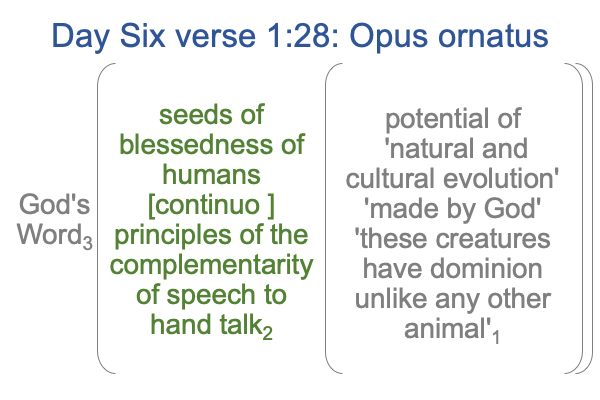
0775 The seeds for giving plants as food for humans associates to relatively recent developments called “the Neolithic Period”. “Neo” means “new”. “Lithic” means stone. New stone tools appear for harvesting and processing grains (in particular). Research on the origins of agriculture(s) is highly evocative. Humans act as agents of natural selection, and the genomes of certain plants change significantly. Small phenotypic changes (such as less toxins in a fruit) motivate humans to propagate certain plants rather than others for the same species.
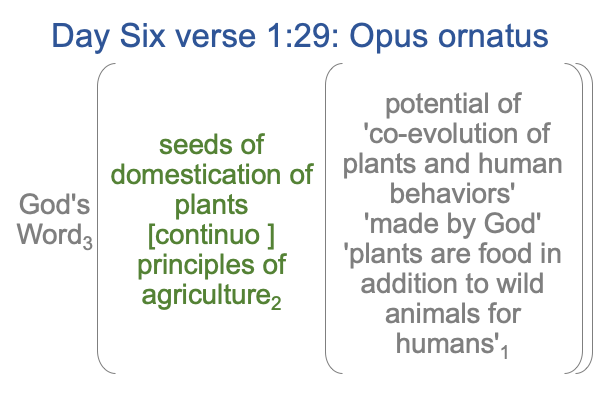
0776 The adornment of the world with the image of God ends with God giving plants as food to animals. What an odd statement to tack at the end of such a fantastic evolutionary narrative. Yet, the Developed Neolithic involves not only the domestication of plants, but also the domestication of animals.
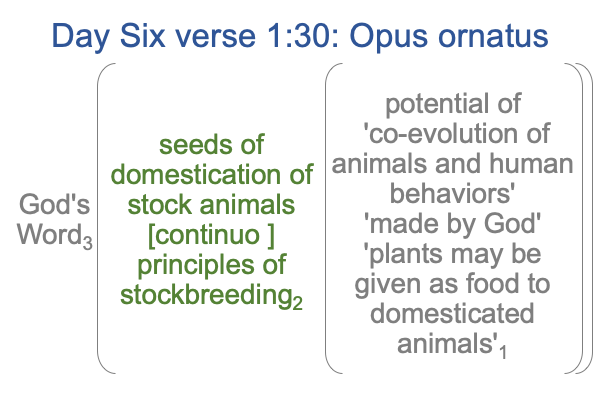
0777 Surely, the way that Thomas Aquinas applies Augustine’s notion of rationes seminales to the six days of creations offers delicious food for thought. Creatio ex nihilo and creatio continua enter the picture as contiguities between two real elements, seed and principle, where the seed is like the esse_ce of esse_ces and the principle is like the essence of essences. A day:age scenario fills out the template for each day is a most satisfying manner.
